Easy Sourdough Ciabatta Rolls
This post may contain affiliate links. Please read our disclosure policy.Crispy on the outside, soft and dotted with holes on the inside, my family can’t get enough of these easy sourdough ciabatta rolls. With no shaping required, these are easy to make and taste incredible. We love them warm out of the oven, toasted for sandwiches or spread with a little bit of butter. Add these easy sourdough ciabatta rolls to your next meal!

Sample Sourdough Schedule for Easy Sourdough Ciabatta Rolls
Ciabatta rolls made with 100% natural yeast takes extra time. Because of this I like to start my sourdough recipes with a sample schedule to get an idea of what the timing looks like. This sample schedule assumes you will be maintaining a dough temperature of 78 degrees F throughout the process.
| 9 AM – 12 PM | Mix Levain. Cover and ferment for about 3-4 hours until doubled in size, bubbly and ripe. |
| 12 PM – 12:30 PM | Fermentolyse. Mix together levain, flour and water. Cover and let sit for 30 minutes to an hour. |
| 12:30 PM – 1 PM | Add salt. Pinch the dough together to incorporate. Let rest. |
| 1:00 PM 1:30 PM 2:00 PM 2:30 PM | Coil Fold #1 Coil Fold #2 Coil Fold #3 Coil Fold #4 |
| 4:00 PM | Finish Bulk Fermentation at 78-80 degrees F. Dough will be aerated, jiggly and have some bubbles on the sides. |
| 4:00 PM – 9:00 AM (next morning) | Cold Fermentation Cover the bowl of dough and stick in the refrigerator overnight for 12-20 hours. |
| 9:00 AM | Cut the dough on the counter into rolls. |
| 9:30 AM – 11:30 AM | Proof the rolls at warm room temperature (78 degrees F) on a baking sheet. |
| 10:45 AM | Preheat oven to 475 degrees Fahrenheit |
| 11:30 AM – 11:50 AM | Bake the rolls |

Ingredients in Easy Sourdough Ciabatta Rolls
- Sourdough Starter: Use an active/ripe sourdough starter (doubled in size/bubbly/mild sour aroma) to mix the levain.
- Bread Flour: I almost always use bread flour for any bread that I am kneading. My bread flour is purchased from a local mill and is about 12.5% protein content. If you don’t have bread flour on hand, make sure to substitute some vital wheat gluten.
- Water: With only 4 ingredients in this recipe, water is important! You may need to use cold or warm water to balance out the ambient temperature. The goal is to keep the dough right around 78 degrees F throughout the bulk fermentation (more info below).
- Salt: Salt is added after a fermentolyse to help the gluten strands develop. It’s important to balance the flavors. Don’t leave it out.

Making a Levain
I use a levain method for making sourdough. You can read more about that here.
For this recipe I use a 3-4 hour levain (1:1:1 ratio):
- 65 grams ripe/mature sourdough starter
- 65 grams all purpose or bread flour
- 65 grams water
Before mixing, take the temperature of the sourdough starter and flour. If it is colder than the 75-80 degree range, use warm water to mix the levain. If the ingredients are warmer than 75-80 degrees, use cooler water. The goal is for the levain to be in the 75-80 degree temperature range. After mixing, cover loosely and let sit for about 3-4 hours (at 75-80 degrees F). If you want to mix levain overnight so it is ready in the morning, mix a 1:10:10 levain with 9 grams ripe sourdough starter, 90 grams flour and 90 grams water. Let sit for 10-12 hours until bubbly, doubled in size and barely beginning to fall back down.
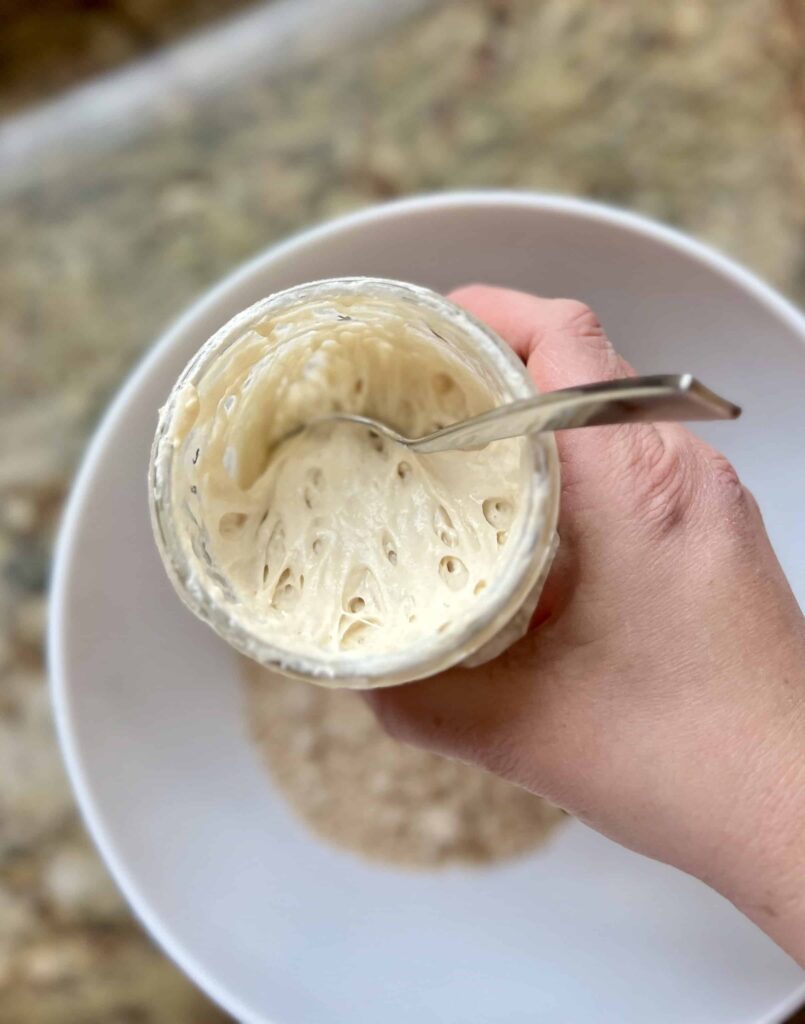
Mixing the Dough
Sourdough ciabatta rolls are easily mixed by hand. I also like using a dough whisk at the beginning for the very sticky parts. Begin with a fermentolyse.
Fermentolyse: Mix together the ripe levain, bread flour and water. Let rest for 30 minutes to allow the gluten strands to begin forming. This is an easy, hands-off way to strengthen the dough.
After 30 minutes, add the salt and pinch together the dough with your fingers, completely incorporating the salt into the dough. Transfer the dough to a shallow container (a glass baking dish works well) and cover. Wait another 30 minutes for the dough to rest and then perform your first set of coil folds. You will perform 3-4 sets of coil folds total over 1.5-2 hours.




More Amazing Roll Recipes
Coil Folding to Strengthen the Dough
The coil fold is a technique of picking up the dough from the middle and letting the dough fall down onto and under itself, resulting in a coil. Once the dough is initially mixed, it will be very sticky. Place the dough in a rectangular container or glass pan. Cover it and let it sit. After half an hour, open the container and perform 4-6 coil folds. The dough will be very sticky for this first set of coil folds but will strengthen over time. Wet your hands with water. Place your hands under the middle of the dough and pull up. The dough will stretch up (but should not tear) and release from the bottom of the bowl. Once the dough releases, let the dough fall back under itself. Repeat the process for both sides of dough. Then turn the container and repeat the coil fold. Don’t worry if the dough is super sticky for the first one or two coil folds. It will transform into beautiful dough throughout this process. You can watch a video of the process here.

End Bulk Fermentation
Total bulk fermentation time is calculated from the time the levain is mixed with the flour until the dough is ready to be shaped or moved to the pizza pan. Typically this takes about 4-5 hours if the dough is kept at 78 degrees F. If the dough is cooler, it will take a little longer. If the dough is warmer it will go faster. Look for these signs that the dough is ready to end the bulk fermentation stage:
- Dough will be puffed up and you may notice a 30 – 40% rise
- Dough will start to round and pull away from the edges just a bit
- Dough will be aerated, smooth and strong
- Bubbles will be scattered around the edges and maybe a few in the middle of the dough

Cold Bulk Ferment
This recipe calls for a cold bulk ferment. An overnight or long ferment in the refrigerator adds more flavor to the dough and creates a better structure. Stick the covered dough in the refrigerator for 12-20 hours before shaping into ciabatta rolls.

Shaping Ciabatta Rolls
The “easy” part of these sourdough ciabatta rolls comes primarily from the low amount of shaping needed. Dump the dough onto a countertop and using a bench scraper, cut the dough into two pieces. Wet your hands and gently form into a rectangle. Cut the rectangle into 6 pieces. Prepare two baking sheets with a layer of parchment paper and using a bench knife, transfer the six pieces of dough to the parchment lined baking sheet. Repeat with the other portion of dough so you have two sheet pans and twelve rolls total.






Proofing Ciabatta Rolls
Spread a little flour over the top of each ciabatta roll. Cover the rolls with a kitchen towel and let proof for 2-3 hours at 78 degrees F. The rolls will puff up a little but won’t rise too much. Preheat the oven to 475 degrees F toward the end of the rise.


Baking Easy Sourdough Ciabatta Rolls
Place a baking stone or a baking sheet on a lower rack in the oven. This helps prevent the bottoms of the ciabatta rolls from burning. Once the oven is preheated, place a pan with about 1 cup of ice cubes on the bottom rack of the oven (or put them on the baking sheet). Quickly slide the ciabatta rolls into the oven. Bake the easy sourdough ciabatta rolls for 20 minutes. Check the rolls. If you want them a little darker, let them cook a few minutes longer. Let cool completely before slicing and enjoying! Add more ice cubes and repeat with the second pan of rolls.




Frequently Asked Questions
Store any leftover ciabatta in an airtight container or ziplock bag in the freezer for up to 3 months.
Yes. Instead of shaping into 12 rolls, cut into two pieces and lightly shape each into a flat rectangle. Place on a parchment-lined baking sheet, let rise and bake for about 30 minutes.
Yes, I recommend adding a few Tablespoons of vital wheat gluten to the all purpose flour or decreasing the water in the recipe a bit if you can’t use bread flour.

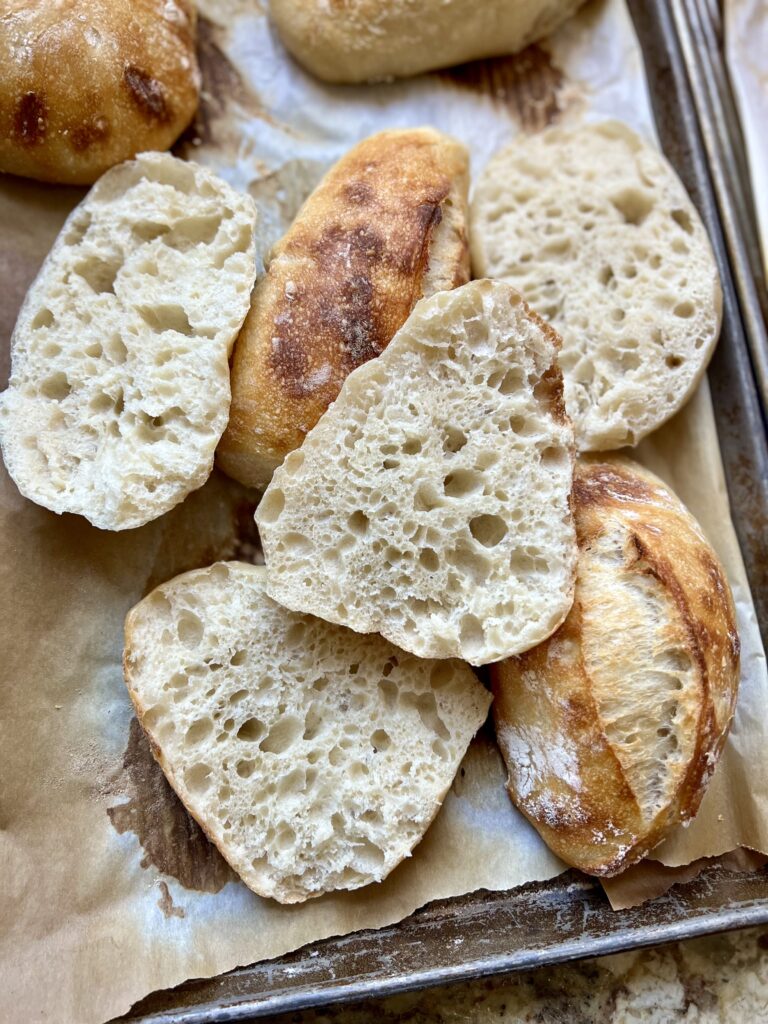
Looking for More Sourdough Recipes?

Easy Sourdough Ciabatta Rolls
Ingredients
Levain
- 65 grams sourdough starter
- 65 grams all purpose flour
- 65 grams water
Sourdough Ciabatta Dough
- 180 grams levain
- 800 grams room temperature water
- 1000 grams bread flour
- 20 grams salt
Instructions
Levain
- Mix the levain together about 3-4 hours before mixing the dough. Take 65 grams of ripe starter and feed it with 65 grams flour and 65 grams water. Mix and cover with plastic wrap. I like to mix this in a liquid measuring cup to watch how much it grows. Once the levain has doubled in size, is rounded on top and just before it starts to go back down is the ideal time to make the ciabatta dough.
Ciabatta Dough
- Fermentolyse: Use a kitchen scale to weigh the ingredients and mix together in a large bowl. Mix together the ripe levain, water and bread flour. Let sit for 30 minutes to 1 hour.
- Add Salt: Weigh 20 grams of salt in a small container. Add the salt to the dough mixture and use your hands to stretch the dough, incorporating the salt as you go. This is a very wet dough. It is helpful to get your hands wet before handling the dough.
- Coil Folds: To develop the dough, perform a series of coil folds over the next 2 hours. To coil fold: Reach on both sides of the dough and pull up, forming a coil with the dough. Don't let the dough rip. Turn the container and repeat the process on a different side of the dough, performing 2-3 coil folds as the dough strengthens. Repeat this process every 15-30 minutes for a total of 4-6 times.
- Bulk Fermentation: Cover the dough and let rise at warm room temperature (about 78 degrees) for about 2 hours. If your kitchen is cooler, let the dough rise a little bit longer.
- Cold Bulk Fermentation: Place the ciabatta dough in the refrigerator overnight or for up to 24 hours before baking.
- Shape Rolls: Line two baking sheets with parchment paper. Dump the cold dough out onto the counter. Wet your hands and cut twelve pieces of dough using a bench scraper. Place each piece of dough on top of the parchment paper leaving some space between each roll.
- Proof the Rolls: Sprinkle a little flour over the top of each roll and use your hand to spread the flour on top of the roll (this keeps a kitchen towel from sticking to the rolls). Place a kitchen towel over the top of the rolls and let them rise at warm room temperature (78 degrees F) until puffed up, about 2 hours. They won't double in size.
- Bake: Preheat oven to 475 degrees Fahrenheit. Place a baking sheet with about 1 cup of ice cubes on the bottom rack of the oven (don't let the ice touch the hot oven glass). Quickly slide the pan of rolls into the oven. Bake rolls for 20 minutes. Let cool completely before slicing and enjoying!

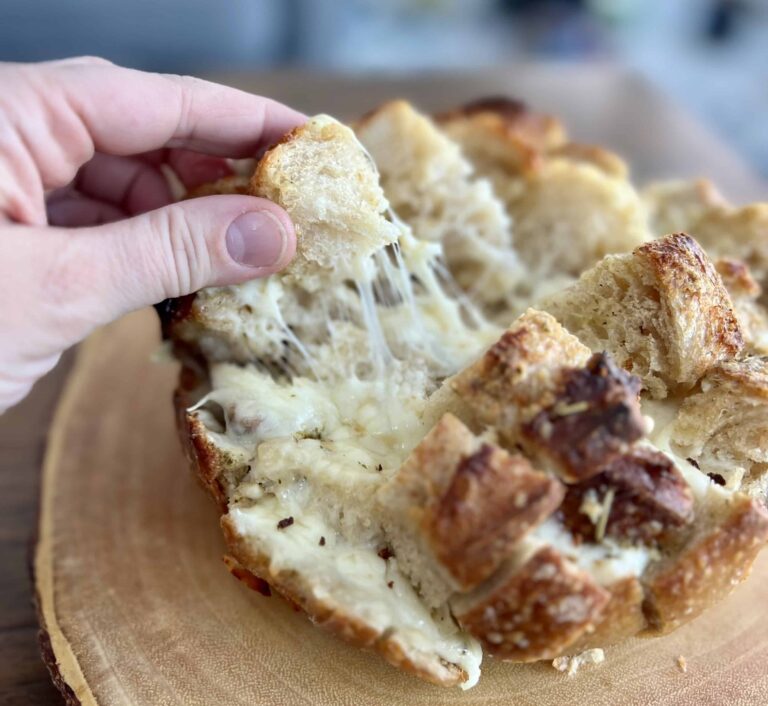
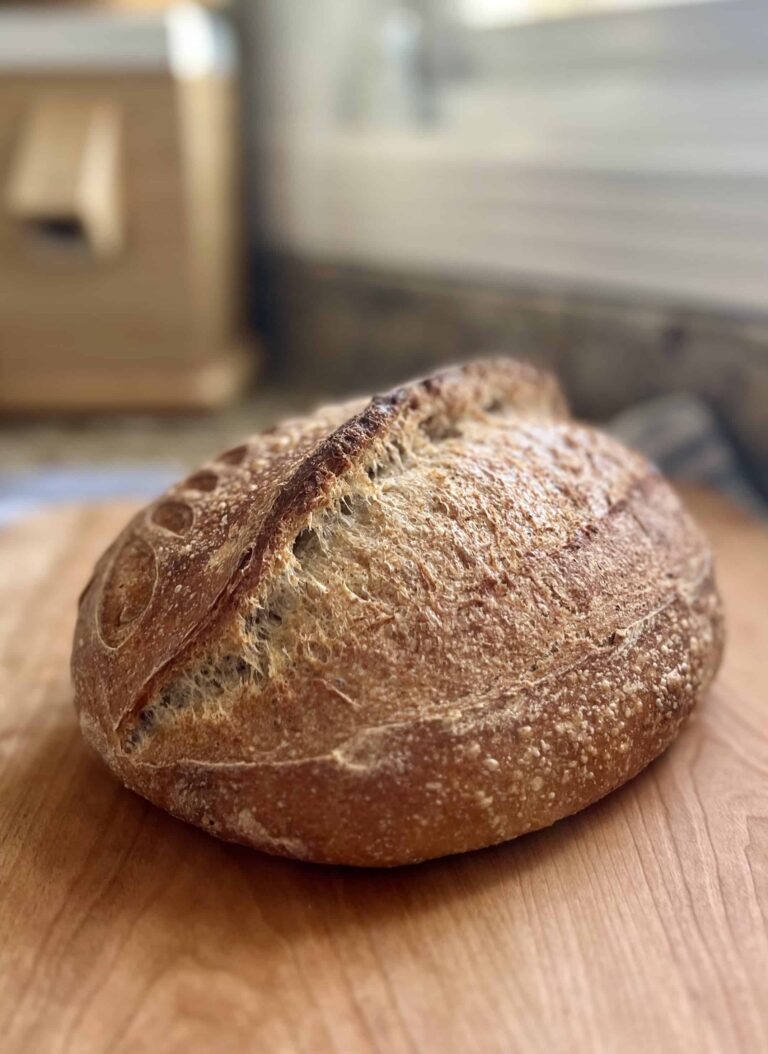



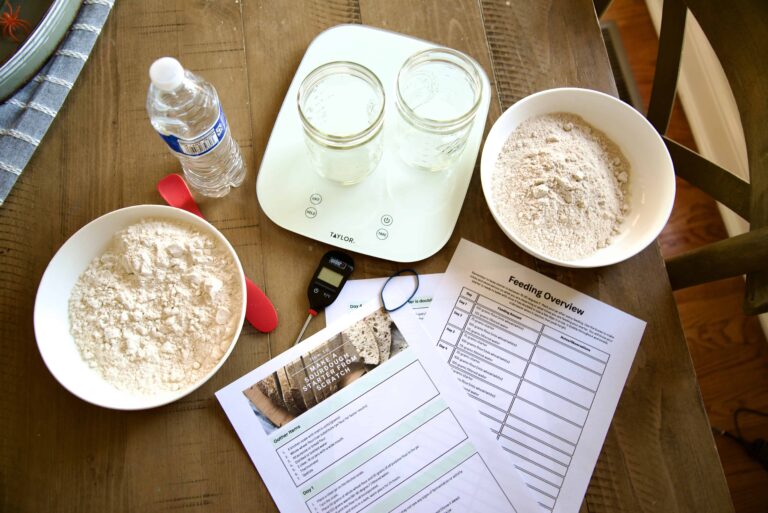
My husband requested I make these ad he had seen some ciabatta videos on Instagram. These were moreish, addictive and didn’t last long! Our family rate this recipe a 9/10 and will definitely make again
So glad you enjoyed these!
Wet your hands and counter when dividing and shaping? Have never heard of this for ciabatta. Did you mean flour the counter, your hands and to put a light dusting of flour on the parchment? Big sticky mess. Check out Alexandra’s Kitchen recipe for success.
Sorry you had a wet sticky mess. You don’t wet the counter, just your hands as the recipe indicates so you are better able to work with the sticky dough. I don’t like to add any extra flour into my dough when I’m shaping it – don’t want it to get worked in. I make these often and haven’t had the issue you’ve had. Make sure to use bread flour or else you need to reduce the water in the dough which can make it too sticky.